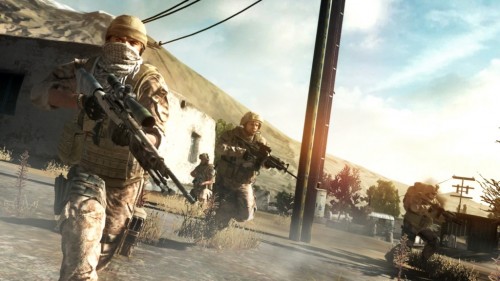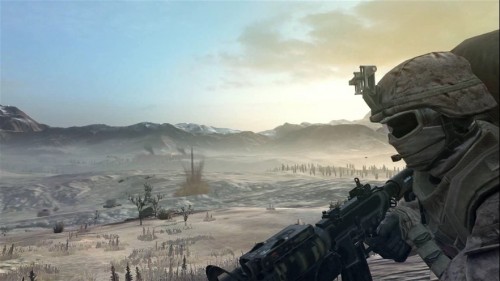War. What is it good for? Edwin Starr’s assertion of “absolutely nuthin’!” was perhaps a bit premature, and who could blame him? I doubt anyone back in the 70s could have predicted that video games based around all kinds of small and large-scale wars would become the preferred genre of choice for the dude-bro generation, and generally being good for lining the pockets of the publishing studios. While it’s widely accepted that the gritty, war-machine FPS genre is over-saturated, it’s certainly not stopping developers from churning out game after game, stacking them on a steadily rising pile that’s sure to come crumbling in on itself at some point (or perhaps it already has?)
Codemasters’ Operation Flashpoint: Red River is the latest installment being added to this pile. Is it relevant? Does it warrant your hard-earned money, and is it worthy of your attention? If said attention span is fairly short, the answer’s probably not. Find out why after the jump.
War: friend only to the undertaker
Players familiar with Operation Flashpoint: Dragon Rising will have a fair idea of what to expect. With the original Operation Flashpoint and the ArmA series often being thrown in the same camp, you should know this: Call of Duty this ain’t. Running and gunning only leads to your untimely demise, often from an enemy still unseen, and any gung-ho attempts at taking on the enemy by yourself will be swiftly nipped in the bud. This is a series where tactical planning, teamwork, and patience are rewarded. While Red River makes a few changes that makes it slightly more accessible, it’s still a game played best using slow and methodical approaches.
This time around, the flashpoint occurs in 2013, within three fairly large districts in Tajikistan. The introductory cut-scene perhaps sets the tone for the rest of the game, with MTV-esque flashing text, annoying American soldier-banter, and rock-and-roll grooves thumping away in the background. Many mid-level checkpoints introduce mind-numbing treks from one checkpoint to the next, for no other apparent reason than to listen to the banal chit-chat of your allies. These aesthetic undertones continue through most of the campaign, but luckily it fails to fully permeate through to the gameplay.
They say we must fight to keep our freedom
Maps are smaller this time around, scripted events are aplenty and checkpoints occur fairly often, but these changes — depending on how realistic you want your first-person-shooters — are mostly for the better. The many checkpoints scattered throughout the campaign make it easier to have shorter bursts of play while still maintaining the feel of being embroiled in lengthy levels of warfare. It’s great for people who do not have the time to invest more than an hour per session.
You have access to four classes: rifleman, automatic rifleman, scout, and grenadier, and these are leveled up as you play with the different classes. Leveling up earns you experience points that you can use to purchase better accessories, attachments, and equipment. With each class being leveled individually, it certainly acts as an incentive to replay the game, even though online play will also contribute to overall experience points gained.
Commands are given to your squad via the radial menu brought up by the L2 button and, once gotten used to, it’s an efficient and quick way to scroll through the various commands you’re able to issue.
While the maps are smaller and more linear than Dragon Rising, it still manages to be both larger and better designed than many of its peers. Listening to commands and chatter of your allies on the battlefield is essential: failure to do so leaves you frantically trying to find enemy positions in typical headless-chicken fashion while bullets zip by. Enemies in Normal mode are highlighted on the radar on your HUD, (you lose the HUD in Hardcore mode) but their distance is often deceiving, and careful navigation between crumbled outposts and sparsely populated areas are essential to staying alive.
Healing yourself with a medkit also takes a sizeable amount of time, and being caught in an ambush midway through healing immediately spells death. New players: you will die, and die often. It is not really an issue given the generous number of checkpoints, but it is definitely an issue given the ridiculous amount of time it takes to reload the checkpoint.
Another problem is the AI of your allies. You often see them being riddled with bullets, yet never so much as attempt to make for cover. There’s a fine line between being selfless and stupid, and your allies definitely lean towards the latter.
Technically, Red River seems to lack the polish of the more established franchises out there, but it doesn’t really detract from an otherwise engaging experience. The frame rate drops severely in places, texture pop-in is generally ever present, and apart from a few very pretty sunsets, it is not exactly what I’d call much of a looker. And yet, with all these shortcomings, I’ve found myself completely invested in the experience. The story is passable, but the real attraction here is the gameplay, which manages to strike an addictive balance between realistic warfare sim and accessibility.
After weathering the rather extensive PSN outage I was also finally able to test out the online multiplayer portion. Featuring a rather sparse offering of only 4-player co-op, it definitely mirrors the same necessary focus on teamwork and communication. If your team mates don’t have headsets you can forget about coming out of any skirmish victorious. And as in the single player campaign, enemies will be able to take you down with a single shot. This creates a tension lacking in most other first-person-shooters, and you’ll often be relying on direction from your squad, and only well-planned coordinated assaults will result in victory. Even so, one can’t help but feel short-changed with the multiplayer content provided, and hopefully additional content—such as a few vs modes—will be added via DLC. It’s still an experience worth having, but lacks serious legs which will often dissuade prospective buyers from committing to it.
Lord knows there’s gotta be a better way
I’m not sure how well Red River will do considering a rather lackluster Dragon Rising reception, but Codemasters has, at the very least, created a compelling template for future titles. The game is certainly not perfect (Ed: Show me a game that is, and I’ll show you a game that doesn’t exist yet), but it manages to succeed where it matters most. Whether we will see another Flashpoint title is perhaps up in the air at the moment, but rated on the single player campaign alone, Red River is, thus far, my most recommended first-person-shooter of 2011.
Score: 7/10





